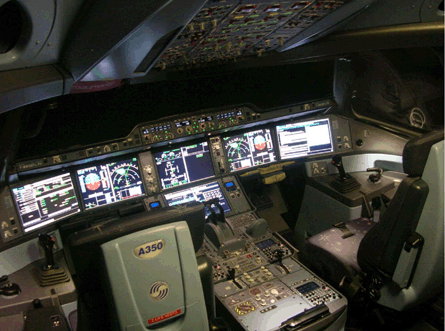As Airbus works to ensure its A350 XWB is not vulnerable to hackers, it has raised some of the burning questions that must be answered before e-enabled airliners are brought to market.
In recent years the US and European certification authorities have expressed their concerns about security of e-enabled aircraft such as the A350, A380, Boeing 787 and Boeing 747-8, through certification review items and special conditions.
The main novelty, according to Airbus, is the use of digital system architecture composed of several connected networks/domains - flight safety-related control, communication and navigation systems; airline business and administrative support; and passenger information and entertainment - and the concern that these networks may be subject to unauthorised access.
 |
|---|
© AirbusAirbus A350 class 2 flight deck |
"As a consequence, 'connectivity' has to be taken in a scope wider than only cabin connectivity, including all kinds of communication [ground system to aircraft systems and aircraft systems to aircraft systems]," said Airbus vice-president, cabin design office Jonathan Norris at a recent World Airline Entertainment Association (WAEA) single focus workshop.
While regulators are concerned that unauthorised people could use in-flight connectivity to hack into on-board systems while physically on board the aircraft, their greater concern is that unauthorised individuals would get into the systems via Gatelink on the ground and load a "false flight management system", Norris says.
As for managing off-board communications, Airbus wants answers to the following:
- Which air-ground (ground-ground) links shall be supported? If this link is shared with cockpit communications, have all necessary studies been done to ensure aircraft performance and security are not affected by such connectivity traffic?
- Are applicable certification rules for new e-enabled aircraft (A350, 787, 747-8) that require segregation between cabin and operational communications met?
To these two points, Airbus has been an advocate for having "a very clean line of segregation", says Norris, noting that "it could be hardware segregation or software segregation".
With respect to managing on-board wireless signals functions, Airbus asks:
- Are the proposed wireless frequencies to be used in line with regulatory standards and Airbus directives?
- Are wireless communications used (or planned) by other maintenance, cabin or cockpit applications? If "yes", Airbus wants to ensure that aircraft performance is not affected, and to secure "the evolution and co-existence of several wireless systems on board as well as continuous compliance to regulatory requirements", says Norris.
Source: Flight International
















